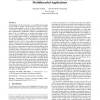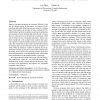1154 search results - page 139 / 231 » Mathematizing C concurrency |
MMAS
2011
Springer
13 years 4 months ago
2011
Springer
While existing mathematical descriptions can accurately account for phenomena at microscopic scales (e.g. molecular dynamics), these are often high-dimensional, stochastic and thei...
WWW
2008
ACM
14 years 9 months ago
2008
ACM
Online collaboration and sharing is the central theme of many webbased services that create the so-called Web 2.0 phenomena. Using the Internet as a computing platform, many Web 2...
PPOPP
2009
ACM
14 years 9 months ago
2009
ACM
Understanding why the performance of a multithreaded program does not improve linearly with the number of cores in a sharedmemory node populated with one or more multicore process...
ICFP
2005
ACM
14 years 9 months ago
2005
ACM
We have designed, implemented, and evaluated AtomCaml, an extension to Objective Caml that provides a synchronization primitive for atomic (transactional) execution of code. A fir...
EUROSYS
2010
ACM
14 years 6 months ago
2010
ACM
Bugs in concurrent programs are extremely difficult to find and fix during testing. In this paper, we propose Kivati, which can efficiently detect and prevent atomicity violat...


